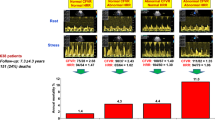Abstract
Coronary microcirculatory function after primary percutaneous coronary intervention (pPCI) in patients with acute myocardial infarction is important determinant of infarct size (IS). Our aim was to investigate the utility of coronary flow reserve (CFR) and diastolic deceleration time (DDT) of the infarct artery (IRA) assessed by transthoracic Doppler echocardiography after pPCI for final IS prediction. In 59 patients, on the 2nd day after pPCI for acute anterior myocardial infarction, transthoracic Doppler analysis of IRA blood flow was done including measurements of CFR, baseline DDT and DDT during adenosine infusion (DDT adeno). Killip class, myocardial blush grade, resolution of ST segment elevation, peak creatine kinase-myocardial band and conventional echocardiographic parameters were determined. Single-photon emission computed tomography myocardial perfusion imaging was done 6 weeks later to define final IS (percentage of myocardium with fixed perfusion abnormality). IS significantly correlated with CFR (r = −0.686, p < 0.01), DDT (r = −0.727, p < 0.01), and DDT adeno (r = −0.780, p < 0.01). CFR and DDT adeno in multivariate analysis remained independent IS predictors after adjustment for other covariates and offered incremental prognostic value in models based on conventional clinical, angiographic, electrocardiographic and enzymatic variables. In predicting large infarction (IS > 20 %), the best cut-off for CFR was <1.73 (sensitivity 65 %, specificity 96 %) and for DDT adeno ≤720 ms (sensitivity 81 %, specificity 96 %). CFR and DDT during adenosine are independent and powerful early predictors of final IS offering incremental prognostic information over conventional parameters of myocardial and microvascular damage and tissue reperfusion.





Similar content being viewed by others
Abbreviations
- ECG:
-
Electrocardiography
- PCI:
-
Percutaneous coronary intervention
- CFR:
-
Coronary flow reserve
- DDT:
-
Diastolic deceleration time
- STEMI:
-
ST segment elevation myocardial infarction
- IRA:
-
Infarct related artery
- SPECT-MPI:
-
Single-photon emission computed tomography-myocardial perfusion imaging
- LAD:
-
Left anterior descending artery
References
Steg PG, James SK, Atar D et al (2012) ESC Guidelines for the management of acute myocardial infarction in patients presenting with ST-segment elevation. Eur Heart J 33:2569–2619
Rigo F, Varga Z, Di Pede F et al (2004) Early assessment of coronary flow reserve by transthoracic Doppler echocardiography predicts late remodeling in reperfused anterior myocardial infarction. J Am Soc Echocardiogr 17:750–755
Meimoun P, Boulanger J, Luycx-Bore A, Zemir H, Elmkies F, Malaquin D et al (2010) Non-invasive coronary flow reserve after successful primary angioplasty for acute anterior myocardial infarction is an independent predictor of left ventricular adverse remodeling. Eur J Echocardiogr 11:711–718
Løgstrup BB, Høfsten DE, Christophersen TB et al (2010) Association between coronary flow reserve, left ventricular systolic function, and myocardial viability in acute myocardial infarction. Eur J Echocardiogr 11(8):665–670
Okcular I, Sezer M, Aslanger E et al (2010) The accuracy of deceleration time of diastolic coronary flow measured by transthoracic echocardiography in predicting long-term left ventricular infarct size and function after reperfused myocardial infarction. Eur J Echocardiogr 11:823–828
TIMI Study Group (1985) The thrombolysis in myocardial infarction (TIMI) trial: phase I findings. N Engl J Med 312:932–936
Lang RM, Bierig M, Devereux RB et al (2006) Recommendations for chamber quantification. Eur J Echocardiogr 7(2):79–108
Djordjevic-Dikic A, Beleslin B, Stepanovic J et al (2011) Prediction of myocardial functional recovery by noninvasive evaluation of basal and hyperemic coronary flow in patients with previous myocardial infarction. J Am Soc Echocardiogr 24:573–581
Iwakura K, Ito H, Takiuchi S, Taniyama Y et al (1996) Alteration in the coronary blood flow velocity pattern in patients with no reflow and reperfused acute MI. Circulation 94:1269–1275
Buller CE, Fu Y, Mahaffey KW, Todaro TG et al (2008) ST-segment recovery and outcome after primary percutaneous coronary intervention for ST-elevation myocardial infarction: insights from the Assessment of Pexelizumab in Acute Myocardial Infarction (APEX-AMI) trial. Circulation 118:1335–1346
Rochitte CE, Lima JA, Bluemke DA, Reeder SB et al (1998) Magnitude and time course of microvascular obstruction and tissue injury after acute myocardial infarction. Circulation 98(10):1006–1014
Sadauskiene E, Zakarkaite D, Ryliskyte L et al (2011) Non-invasive evaluation of myocardial reperfusion by transthoracic Doppler echocardiography and single-photon emission computed tomography in patients with anterior acute myocardial infarction. Cardiovasc Ultrasound 9:16
Van Herck PL, Paelinck BP, Haine SE et al (2013) Impaired coronary flow reserve after a recent myocardial infarction: correlation with infarct size and extent of microvascular obstruction. Int J Cardiol 167(2):351–356
Sezer M, Umman B, Okcular I, Nisanci Y, Umman S (2007) Relationship between microvascular resistance and perfusion in patients with reperfused acute myocardial infarction. J Interv Cardiol 20:340–350
Kitabata H, Imanishi T, Kubo T et al (2009) Coronary microvascular resistance index immediately after primary percutaneous coronary intervention as a predictor of the transmural extent of infarction in patients with ST-segment elevation anterior acute myocardial infarction. JACC Cardiovasc Imaging 2:263–272
Miller TD, Christian TF, Hopfenspirger MR, Hodge DO, Gersh BJ, Gibbons RJ (1995) Infarct size after acute myocardial infarction measured by quantitative tomographic 99mTc sestamibi imaging predicts subsequent mortality. Circulation 92:334–341
Ueno Y, Nakamura Y, Kinoshita M, Fujita T, Sakamoto T, Okamura H (2002) Can coronary flow velocity reserve determined by transthoracic Doppler echocardiography predict the recovery of regional left ventricular function in patients with acute myocardial infarction? Heart 88:137–141
Acknowledgments
This work was supported by the Grant from Ministry of education and science, Republic of Serbia, No 41022.
Conflict of interest
The authors declare no conflict of interest.
Author information
Authors and Affiliations
Corresponding author
Rights and permissions
About this article
Cite this article
Trifunovic, D., Sobic-Saranovic, D., Beleslin, B. et al. Coronary flow of the infarct artery assessed by transthoracic Doppler after primary percutaneous coronary intervention predicts final infarct size. Int J Cardiovasc Imaging 30, 1509–1518 (2014). https://doi.org/10.1007/s10554-014-0497-6
Received:
Accepted:
Published:
Issue Date:
DOI: https://doi.org/10.1007/s10554-014-0497-6




